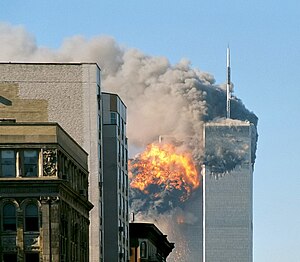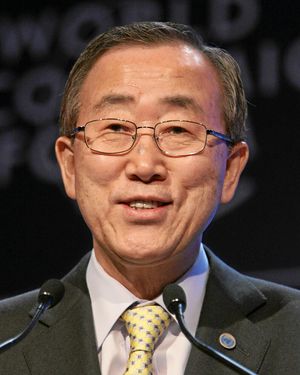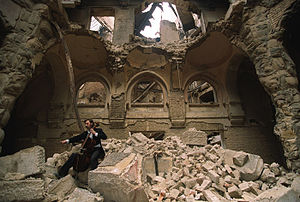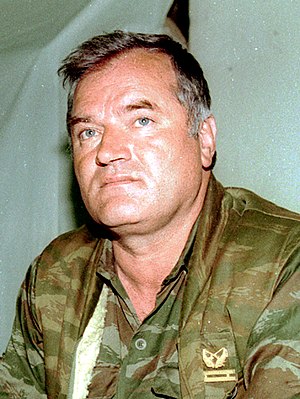The war came about as a result of the
breakup of Yugoslavia. Following the
Slovenian and Croatian secessions from the
Socialist Federal Republic of Yugoslavia in 1991, the multi-ethnic
Socialist Republic of Bosnia and Herzegovina, which was inhabited by
MuslimBosniaks (44 percent),
OrthodoxSerbs (31 percent) and
CatholicCroats (17 percent), passed a
referendum for independence on 29 February 1992. This was rejected by the political representatives of the Bosnian Serbs, who had boycotted the referendum and established their own republic. Following the declaration of
independence, the
Bosnian Serbs, supported by the
Serbian government of
Slobodan Milošević and the
Yugoslav People's Army (JNA), mobilized their forces inside the Republic of Bosnia and Herzegovina in order to secure Serbian territory, then war soon broke out across the country, accompanied by the ethnic cleansing of the Bosniak population, especially in eastern Bosnia.
[11]
The Serbs, although initially superior due to the vast amount of weapons and resources provided by the JNA, eventually lost momentum as the Bosniaks and Croats allied themselves against the Republika Srpska in 1994 with the creation of the
Federation of Bosnia and Herzegovina following the
Washington agreement. After the
Srebrenica and
Markale massacres,
NATO intervened during the 1995
Operation Deliberate Force against the positions of the
Army of the Republika Srpska, which proved key in ending the war.
[18][19] The war was brought to an end after the signing of the General Framework Agreement for Peace in Bosnia and Herzegovina in Paris on 14 December 1995. Peace negotiations were held in
Dayton, Ohio, and were finalized on 21 December 1995. The accords are now known as the
Dayton Agreement.
[20] A 1995 report by the
Central Intelligence Agency found that Bosnian Serb forces were responsible for 90% of the war crimes committed during the conflict.
[21] As of early 2008, the
International Criminal Tribunal for the former Yugoslavia had convicted 45 Serbs, 12
Croats and 4
Bosniaks of war crimes in connection with the war in Bosnia.
[22] The most recent figures suggest that around 100,000 people were killed during the war.
[23][24] In addition, some 20,000 to 50,000 women were raped,
[25] and over 2.2 million people were displaced,
[26] making it the most devastating conflict in Europe since the end of
World War II.
The war in Bosnia and Herzegovina came about as a result of the breakup of the
Socialist Federal Republic of Yugoslavia. Crisis emerged in Yugoslavia with the weakening of the Communist system at the end of the
Cold War. In Yugoslavia, the national Communist party, officially called the Alliance or
League of Communists of Yugoslavia, was losing its ideological potency. Meanwhile nationalism, after violence had broke out in Kosovo, experienced a renaissance in the 1980s.
[27] While the goal of Serbian nationalists was the centralisation of Yugoslavia, other nationalities in Yugoslavia aspired to the federalisation and the decentralisation of the state.
[28]In March 1989, the crisis in Yugoslavia deepened after the adoption of amendments to the Serbian Constitution that allowed the government of Serbia to impose dominance over the autonomous provinces of
Kosovo and
Vojvodina.
[29] Until that point,
Kosovo and
Vojvodina's decision-making had been independent and both autonomous provinces also had a vote at the Yugoslav federal level. Serbia, under newly elected President
Slobodan Milošević, thus gained control over three out of eight votes in the
Yugoslav presidency. With additional votes from
Montenegro, Serbia was thus able to heavily influence decisions of the federal government. This situation led to objections in other republics and calls for the reform of the Yugoslav Federation.
At the 14th Extraordinary Congress of the League of Communists of Yugoslavia, on 20 January 1990, the delegations of the Republics could not agree on the main issues in the Yugoslav federation. As a result, the
Slovenian and Croatian delegates left the Congress. The Slovenian delegation, headed by
Milan Kučan demanded democratic changes and a looser federation, while the Serbian delegation, headed by Milošević, opposed it. This event is considered to have been the beginning of the end of
Yugoslavia.
Moreover, nationalist parties attained power in other republics. Among them, the Croatian
Franjo Tuđman's
Croatian Democratic Union (HDZ) was the most prominent. On 22 December 1990, the
Parliament of Croatia adopted a new Constitution, taking away some of the rights of the Serbs granted by the previous Socialist constitution. This created grounds for nationalist action among the indigenous Serbs of Croatia. Closely following the adoption of the new constitution, Slovenia and Croatia began the process towards independence. On 25 June 1991, both Slovenia and Croatia declared independence which led to a short armed conflict in Slovenia called the
Ten-Day War, and an all-out war in Croatia in the
Croatian War of Independence in areas with substantial Serb populations. The Croatian War of Independence would result in
U.N. Security Council Resolution 743 on 21 February 1992, which created the
United Nations Protection Force (UNPROFOR) in accordance with the Secretary-General's report S/23592 of 15 February 1992.
Bosnia and Herzegovina
Bosnia and Herzegovina, former
Ottoman province, has historically been a multi-ethnic state. According to the 1991 census, 44% of the population considered themselves Muslim (Bosniak), 32.5% Serb and 17% Croat, with 6% describing themselves as Yugoslav.
[30]On 13 October 1991 Bosnian Serb leader
Radovan Karadžić expressed his view about future of Bosnia and Bosnian Muslims:
"In just a couple of days, Sarajevo will be gone and there will be five hundred thousand dead, in one month Muslims will be annihilated in Bosnia and Herzegovina".[32] Karađorđevo agreement
Discussions between
Franjo Tuđman and
Slobodan Milošević included "
...the partition of Bosnia and Herzegovina between Serbia and Croatia."
[33] were held as early as March 1991 known as
Karađorđevo agreement. Following the declaration of
independence of Republic of Bosnia and Herzegovina, the Serbs from B&H with support
[citation needed] from Serbia, attacked different parts of the country. The state administration of Bosnia and Herzegovina effectively ceased to function having lost control over the entire territory. The Serbs wanted all lands where Serbs had a majority, eastern and western Bosnia. The Croats and their leader
Franjo Tuđman also aimed at securing parts of Bosnia and Herzegovina as Croatian. The policies of the Republic of Croatia and its leader Franjo Tuđman towards Bosnia and Herzegovina were never totally transparent and always included Franjo Tuđman's ultimate aim of expanding Croatia's borders.
[34] Bosniaks were an easy target, because the Bosnian government forces were poorly equipped and unprepared for the war.
[15] Independence of Bosnia and Herzegovina
On 15 October 1991, the parliament of the Socialist Republic of Bosnia and Herzegovina in Sarajevo passed a "Memorandum on the Sovereignty of Bosnia-Herzegovina" by a simple majority.
[35][36] The Memorandum was hotly contested by the Bosnian Serb members of parliament, arguing that Amendment LXX of the Constitution required procedural safeguards and a 2/3 majority for such issues, but the Memorandum was debated anyway, leading to a boycott of the parliament by the Bosnian Serbs, and during the boycott the legislation was passed.
[37]On 25 January 1992, an hour after the session of parliament was adjourned, the parliament called for a referendum on independence on 29 February and 1 March.
[35]The Bosnian Serbian assembly members invited the
Serb population to boycott the referendums held on 29 February and 1 March 1992. The turnout to the referendums was reported as 63.7%, with 92.7% of voters voting in favour of independence (implying that Bosnian Serbs, which made up approximately 34% of the population, largely boycotted the referendum).
[39] Independence was declared on 5 March 1992 by the parliament. The Serb political leadership used the referendums as a pretext to set up roadblocks in protest.
Establishment of Republika Srpska
On 7 January 1992, the Serb members of the Prijedor Municipal Assembly and the presidents of the local Municipal Boards of the
SDS proclaimed the Assembly of the Serbian People of the Municipality of Prijedor and implemented secret instructions that were issued earlier on 19 December 1991. The "
Organisation and Activity of Organs of the Serbian People in Bosnia and Herzegovina in Extraordinary Circumstances" provided a plan for the SDS take-over of municipalities in BiH, it also included plans for the creation of Crisis Staffs.
[41]Milomir Stakić, later convicted by
ICTY of mass
crimes against humanity against Bosniak and Croat civilians, was elected President of this Assembly.
[42]On 17 January 1992, the Prijedor Serb Assembly endorsed joining the Serbian territories of the Municipality of Prijedor to the Autonomous Region of Bosnian Krajina in order to create a separate Serbian state in ethnic Serbian territories.
[42]On 28 February 1992, the Constitution of the SR BiH declared that the territory of that Republic included "the territories of the Serbian Autonomous Regions and Districts and of other Serbian ethnic entities in Bosnia and Herzegovina, including the regions in which the Serbian people remained in the minority due to the genocide conducted against it in World War II", and it was declared to be a part of Yugoslavia.
[41]On 12 August 1992, the name of the SR BiH was changed to Republika Srpska ("RS").
[41][43] Establishment of the Croatian Republic of Herzeg-Bosnia
The objectives of the nationalists from Croatia were shared by Croat nationalists in Bosnia and Herzegovina.
[44] The ruling party in the
Republic of Croatia, the
Croatian Democratic Union (HDZ), organized and controlled the branch of the party in Bosnia and Herzegovina. By the latter part of 1991, the more extreme elements of the party, under the leadership of
Mate Boban,
Dario Kordić,
Jadranko Prlić, Ignac Koštroman and local leaders such as Anto Valenta,
[44] and with the support of
Franjo Tuđman and
Gojko Šušak, had taken effective control of the party. This coincided with the peak of the
Croatian War of Independence. On 18 November 1991, the party branch in Bosnia and Herzegovina, proclaimed the existence of the
Croatian Republic of Herzeg-Bosnia, as a separate "political, cultural, economic and territorial whole", on the territory of Bosnia and Herzegovina.
[45] Carrington-Cutileiro Plan
The
Lisbon Agreement, also known as the Carrington-Cutileiro plan, named for its creators
Lord Carrington and Portuguese Ambassador
José Cutileiro, resulted from the
European Economic Community-hosted conference held in September 1991 in an attempt to prevent Bosnia and Herzegovina sliding into war. It proposed ethnic power-sharing on all administrative levels and the devolution of central government to local ethnic communities. However, all Bosnia and Herzegovina's districts would be classified as Bosniak, Serb or Croat under the plan, even where ethnic majority was not evident.
However, on 28 March 1992, Izetbegović, after meeting with the then-US ambassador to Yugoslavia
Warren Zimmermann in Sarajevo, withdrew his signature and declared his opposition to any type of ethnic division of Bosnia.
What was said and by whom remains unclear. Zimmerman denies that he told Izetbegovic that if he withdrew his signature, the United States would grant recognition to Bosnia as an independent state. What is indisputable is that Izetbegovic, that same day, withdrew his signature and renounced the agreement.
[46]
Arms Embargo
On 25 September 1991, the
United Nations Security Council passed
Resolution 713 imposing an arms embargo on all of the former-Yugoslavia. The embargo hurt the
Army of Republic of Bosnia and Herzegovina the most because the Republic of
Serbia inherited the lion's share of the Yugoslav People Army's arsenal and the Croatian Army could smuggle weapons through its coast. Over 55% of the armories and barracks of the former Yugoslavia were located in Bosnia owing to its mountainous terrain, in anticipation of a guerrilla war, but many of those factories were under Serb control (such as the UNIS PRETIS factory in
Vogošća), and others were inoperable due to a lack of electricity and raw materials. The Bosnian government lobbied to have the embargo lifted but that was opposed by the United Kingdom, France and Russia. US proposals to pursue this policy were known as
lift and strike. The US congress passed two resolutions calling for the embargo to be lifted but both were vetoed by President
Bill Clinton for fear of creating a rift between the US and the aforementioned countries. Nonetheless, the United States used both "
black" C-130 transports and
back channels including
Islamist groups to smuggle weapons to Bosnian-Muslim forces via Croatia.
[47]War in Herzegovina
The
Croatian Community of Herzeg-Bosnia took control of many municipal governments and services in
Herzegovina as well, removing or marginalising local Bosniak leaders. Herzeg-Bosnia took control of the media and imposed Croatian
ideas and
propaganda. Croatian
symbols and currency were introduced, and Croatian curricula and the Croatian language were introduced in schools. Many Bosniaks and Serbs were removed from positions in government and private business; humanitarian aid was managed and distributed to the Bosniaks' and Serbs' disadvantage; and Bosniaks in general were increasingly harassed. Many of them were deported into
concentration camps:
Heliodrom, Dretelj, Gabela, Vojno and Šunje.
According to ICTY judgment in
Naletilić-Martinović case HVO forces attacked the villages of Sovici and Doljani, about 50 kilometers north of Mostar in the morning on 17 April 1993.
[15] The attack was part of a larger HVO offensive aimed at taking
Jablanica, the main Bosnian Muslim dominated town in the area. The HVO commanders had calculated that they needed two days to take Jablanica. The location of Sovici was of strategic significance for the HVO as it was on the way to Jablanica. For the ARBiH it was a gateway to the plateau of Risovac, which could create conditions for further progression towards the Adriatic coast. The larger HVO offensive on Jablanica had already started on 15 April 1993. The artillery destroyed the upper part of Sovici. The Bosnian Army was fighting back, but at about five p.m. the Bosnian Army commander in Sovici, surrendered. Approximately 70 to 75 soldiers surrendered. In total, at least 400 Bosnian Muslim civilians were detained. The HVO advance towards Jablanica was halted after a cease-fire agreement had been negotiated.
[15] Siege of Mostar
The Eastern part of
Mostar was surrounded by HVO forces for nine months, and much of its historic city was severely damaged in
shelling including the famous
Stari Most bridge.
[45]Mostar was divided into a Western part, which was dominated by the HVO forces and an Eastern part where the ARBiH was largely concentrated. However, the Bosnian Army had its headquarters in West Mostar in the basement of a building complex referred to as Vranica. In the early hours of 9 May 1993, the Croatian Defence Council attacked Mostar using artillery, mortars, heavy weapons and small arms. The HVO controlled all roads leading into Mostar and international organisations were denied access. Radio Mostar announced that all Bosniaks should hang out a white flag from their windows. The HVO attack had been well prepared and planned.
[15]The HVO took over the west side of the city and expelled thousands of Bosniaks from the west side into the east side of the city.
[45] The HVO shelling reduced much of the east side of Mostar to rubble. The JNA demolished Carinski Bridge, Titov Bridge and Lucki Bridge over the river excluding the
Stari Most. HVO forces (and its smaller divisions) engaged in a mass execution, ethnic cleansing and rape on the Bosniak people of the West Mostar and its surroundings and a fierce siege and shelling campaign on the Bosnian Government run East Mostar. HVO campaign resulted in thousands of injured and killed.
[45]The ARBiH launched an operation known as
Operation Neretva '93 against the HVO and
Croatian Army in September 1993 to end the siege of Mostar, and recapture areas of Herzegovina that were included in the self-proclaimed
Croatian Republic of Herzeg-Bosnia.
[74] The operation was stopped by Bosnian authorities after it received information about the massacre against Croat civilians and POWs in the villages of Grabovica and Uzdol.
UNPROFOR and NATO
NATO became actively involved, when its jets
shot down four Serb aircraft over central Bosnia on 28 February 1994 for violating the UN no-fly zone.
[81] On 12 March 1994, the
United Nations Protection Force (UNPROFOR) made its first request for NATO air support, but close air support was not deployed, however, owing to a number of delays associated with the approval process.
[82] On 20 March an aid convoy with medical supplies and doctors reached
Maglaj, a city of 100,000 people, which had been under siege since May 1993 and had been surviving off food supplies dropped by
US aircraft.
[80] A second convoy on 23 March was hijacked and looted.
[80]On 10 and 11 April 1994 UNPROFOR called in air strikes to protect the
Goraždesafe area, resulting in the bombing of a Serbian military command outpost near Goražde by 2 US
F-16 jets.
[75][80][82] This was the first time in NATO's history it had ever done so.
[80] This resulted in the taking of 150 U.N. personnel hostage on 14 April.
[75][82] On 16 April a British
Sea Harrier was shot down over Goražde by Serb forces.
[80] On 15 April the Bosnian government lines around Goražde broke.
[80]Around 29 April a Danish contingent (Nordbat 2) on peacekeeping duty in
Bosnia, as part of UNPROFOR's Nordic battalion located in
Tuzla, was ambushed when trying to relieve a Swedish observation post (Tango 2) that was under heavy artillery fire by the
Bosnian SerbŠekovići brigade at the village of
Kalesija, but the ambush was dispersed when the UN forces retaliated with heavy fire in what would be known as
Operation Bøllebank.
On 12 May, the
US Senate adopted
S. 2042 from Sen.
Bob Dole to unilaterally lift the arms embargo against the Bosnians, but was repudiated by President Clinton.
[83][84]Pub.L. 103–337 was signed by the President on 5 October 1994 and stated that if the Bosnian Serbs had not accepted the Contact Group proposal by 15 October the President should introduce a UN Security Council proposal to end the arms embargo and that if it was not passed by 15 November only funds required by all UN members under Resolution 713 could be used to enforce the embargo, effectively ending the arms embargo.
[85]On 5 August, at the request of UNPROFOR, NATO aircraft attacked a target within the Sarajevo Exclusion Zone after weapons were seized by Bosnian Serbs from a weapons collection site near Sarajevo.
[75] On 22 September 1994 NATO aircraft carried out an air strike against a Bosnian Serb tank at the request of UNPROFOR.
[75]On 12–13 November, the US unilaterally lifted the arms embargo against the government of Bosnia.
[85][86]Operation Amanda was an UNPROFOR mission led by
Danish peacekeeping troops, with the aim of recovering an observation post near
Gradačac, Bosnia and Herzegovina, on 25 October 1994.
[87] On 19 November the North Atlantic Council approved the extension of Close Air Support to Croatia for the protection of UN forces in that country.
[75] NATO aircraft attacked the
Udbina airfield in Serb-held Croatia on 21 November, in response to attacks launched from that airfield against targets in the Bihac area of Bosnia and Herzegovina.
[75] On 23 November, after attacks launched from a surface-to-air missile site south of Otoka (north-west Bosnia and Herzegovina) on two NATO aircraft, air strikes were conducted against air defence radars in that area.
[75]Books
Zlata's Diary is a published diary kept by a young girl,
Zlata Filipović, which chronicles her life in Sarajevo from 1991 to 1993. Because of her diary, she is sometimes referred to as "The Anne Frank of Sarajevo".
Plays about the war include
Necessary Targets, written by
Eve Ensler. It has also been suggested that "
Caryl Churchill"'s
Far Away is a response to the Bosnian War.
A book on the Bosnian War called
My WarGone by, I Miss it so by
Anthony Loyd depicts the view of a freelance war photographer.
Winter Warriors – Across Bosnia with the PBI by Les Howard, is a factual account of a British Territorial (reserve) infantry soldier who volunteered to serve as a UN Peacekeeper in the latter stages of the war, and also during the first stages of the NATO led Dayton Peace Accord. This critically acclaimed work gives an in depth feel to the perils of peacekeeping, the harsh landscape and the resolve of the British soldier, a much overlooked quality that contributed to a lasting peace.
Pretty Birds, by Scott Simon, depicts a teenage girl in Sarajevo, once a basketball player on her high school team, becomes a sniper.
The Cellist of Sarajevo, by
Steven Galloway, is a novel following the stories of four people living in Sarajevo during the war.
Life's Too Short to Forgive, written in 2005 by Len Biser, follows the efforts of three people—a courageous Bosnian woman soldier, a former UNPROFOR Lieutenant, and a private citizen—who unite to assassinate Karadzic to stop Serb atrocities.
Evil Doesn't Live Here, by Daoud Sarhandi and Alina Boboc, presents a large number of posters portraying the war, from all sides in the conflict and many regions throughout Bosnia-Herzegovina.
Balkan, In Memoriam, by Sandra Balsells, a testimonial stirred about the evolution of the old Yugoslavia since the disintegration of the country in 1991 until the fall of Milosevic in 2000.
"Hotel Sarajevo" by Jack Kersh
Top je bio vreo by Vladimir Kecmanović, a story of a Bosnian Serb boy in the part of Sarajevo held by Bosnian Muslim forces during the
Siege of Sarajevo.
I Bog je zaplakao nad Bosnom (And God cried over Bosnia), written by Momir Krsmanović, is a depiction of war that mainly focuses on the crimes committed by Muslim people.
Dampyr is an Italian
comic book, created by Mauro Boselli and Maurizio Colombo and published in Italy by
Sergio Bonelli Editore about Harlan Draka, half human, half vampire, who wages war on the multifaceted forces of Evil. The first two episodes are located in Bosnia and Herzegovina (#1 Il figlio del Diavolo) i.e. Sarajevo (#2 La stirpe della note) during the Bosnian war.
"Blasted", by playwright Sarah Kane, is in part about the Bosnian War.
Goodbye Sarajevo – A True Story of Courage, Love and Survival by Atka Reid and Hana Schofield and published in 2011, is the story of two sisters from Sarajevo and their separate experiences of the war.
Love Thy Neighbor: A Story of War by Peter Maas, published in 1997 is his account as a reporter at the height of the Bosnian War. This book examines, with scathing inquiry, the horrors and desperation suffered by the Bosnian people.
"Bluebird: A Memoir" By Vensa Maric are the recently published memoir's of the authors experiences as a refugee during the Bosnian war, when she was sent to England to escape the conflict.
[edit]Photography
The 2006
Annie Leibovitz collection,
A Photographer's Life, includes photographs of Sarajevo during this period. "
Return with Honor" by: Captain Scott O'Grady.
1994, Bosnia, War in Europe – Images by Wolfgang Bellwinkel and Peter Maria Schäfer, expose
Music
In
State Radio's album titled Let It Go, the song Bohemian Grove references the war, saying in the first verse, "Could've stopped Sarajevo, we must confess, but we were planning our next invasion."
Nirvana had created a benefit show for the rape victims of Croatia. The bassist, Krist Novoselic is of Croatian background so this was personal. Frontman, Kurt Cobain had previously written an anti-rape song (Rape Me) and about a rape victim (Polly) both of which they had played at the show.
Other media






























 WikiMiniAtlas
WikiMiniAtlas












